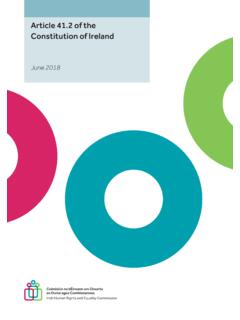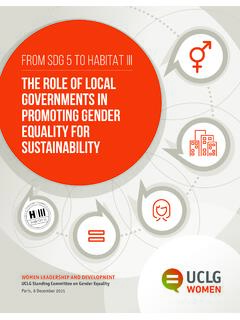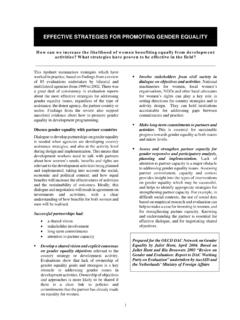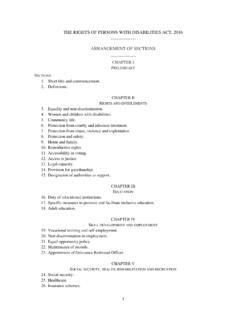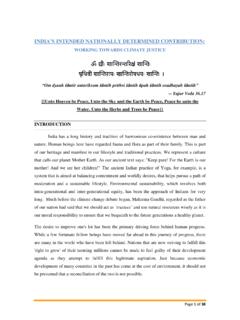Transcription of Attitudes to Diversity in Ireland - IHREC
1 Attitudes to Diversity in IrelandM a rch 2018 Frances McGinnity, Raffaele Grotti, Helen Russell and amonn FaheyRESEARCH SERIESA ttitudes to Diversity in IrelandM a rch 2018 Frances McGinnity, Raffaele Grotti, Helen Russell and amonn FaheyRESEARCH SERIESThis report was written by Frances McGinnity, Raffaele Grotti, Helen Russell and amonn Fahey. It was prepared for the Irish Human Rights and equality Commission by the Economic and Social Research Institute as part of the Research Programme on Human Rights and equality . The report has been peer -reviewed prior to publication. The views expressed in this report are those of the authors and do not necessarily represent those of the Economic and Social Research Institute or the Irish Human Rights and equality Commission. The Irish Human Rights and equality Commission was established under statute on 1 November 2014 to protect and promote human rights and equality in Ireland , to promote a culture of respect for human rights, equality and intercultural understanding, to promote understanding and awareness of the importance of human rights and equality , and to work towards the elimination of human rights abuses and discrimination.
2 The Economic and Social Research Institute (ESRI) is an independent research institute working towards a vision of Informed policy for a better Ireland . The ESRI seeks to support sustainable economic growth and social progress in Ireland by providing a robust knowledge base capable of providing effective solutions to public policy challenges. 2018. Copyright is held jointly by the Economic and Social Research Institute and theIrish Human Rights and equality Human Rights and equality Commission, 16 22 Green Street, Dublin Economic and Social Research Institute, Whitaker Square, Sir John Rogerson s Quay, Dublin 978-0-7070-0449-5 DOI Available to download from FOREWORD This report, Attitudes to Diversity in Ireland , carried out by the Economic and Social Research Institute (ESRI), i s the second in a series of research publications for the Irish Human Rights and equality Commission, as part of the Commission s research programme.
3 It is also the first major report devoted to Attitudes to immigrants in Ireland . It is well documented that during the pas t two decades Ireland has become a n increasingly diverse country. The 2016 Census indicates that the 535,475 non-Irish nationals living in Ireland originate from 200 different nations. The largest group are Polish nationals at 122,515, followed by 103,113 UK nationals, and 36,552 Lithuanians. Overall, there are 12 nationalities with more than 10,000 residents living here in Ireland from America, Brazil, France, Germany, India, Italy, Latvia, Romania, and Spain, in addition to Poland, Lithuania and the UK. As well as making Ireland s population more diverse, immigrants to Ireland are themselves enormously varied in their age profile, their socio-economic background, their religious beliefs and customs, and their proficiency in the English language. This Diversity in our communities can affect, and create, challenges in certain areas, for example in the provision of public services such as education and health, how people access work, and how they experience Irish society.
4 To support an integrated society, it is important for us to know how people in Ireland feel about the changes we are experiencing in the population. This report examines data from the European Social Survey on Attitudes to immigration in Ireland among the Irish-born population. As the data used in this report is collected throughout Europe, the results for Ireland are compared to other West European countries. This means we have an indication of how Attitudes in Ireland compare to our European counterparts. The timeframe for the data is 2002-2014, therefore establishing if Attitudes have changed or remained the same over time. The report also examines the kind of factors which influence Attitudes to Diversity . The relatively high levels of discriminatory Attitudes detailed in this study are a matter for concern. However, the evidence in this report also demonstrates that Attitudes to Diversity are a product of our social, economic and cultural life.
5 They cannot be divorced from how we live both together and as individuals. This insight offers policy makers some direction when it comes to building a more inclusive, more tolerant society. Those factors which influence Attitudes to Diversity economic inclusion, educational attainment and the quality of our communities are such that progress, when it is made, benefits all. The Irish Human Rights and equality Commission works in a variety of ways to protect and promote human rights and equality in Ireland . This report offers us an understanding of prevailing Attitudes to Diversity and how those Attitudes are formed, and will help us in our mission to build a fair and inclusive society that protects and promotes human rights and equality . Its findings will also inform the Commission s submission to the forthcoming treaty monitoring process for the UN Committee on the Elimination of Racial Discrimination.
6 Finally, I would like to thank the ESRI for their engagement, and the report s authors, Professor Frances McGinnity, Dr Raffaele Grotti, Professor Helen Russell and amonn Fahey. Emily Logan Chief Commissioner, Irish Human Rights and equality Commission. THE AUTHORS Frances McGinnity is an Associate Research Professor at the ESRI and an Adjunct Professor at Trinity College Dublin (TCD). Raffaele Grotti is a Post-doctoral Research Fellow at the ESRI. amonn Fahey is a Research Assistant at the ESRI. Helen Russell is a Research Professor at the ESRI and an Adjunct Professor at TCD. ACKNOWLEDGEMENTS We gratefully acknowledge the funding received from the Irish Human Rights and equality Commission ( IHREC ) to support this research programme. We would like to thank the members of the steering board for their input and constructive comments Cliona Doherty ( IHREC ), Laurence Bond ( IHREC ) and Gr inne Collins (NDA).
7 The report also benefited greatly from the comments of two ESRI reviewers and an external expert reviewer, as well as Emer Smyth, who acted as editor of the report. Table of contents | iii TABLE OF CONTENTS EXECUTIVE SUMMARY .. VII CHAPTER 1 INTRODUCTION AND MOTIVATION .. 1 CHAPTER 2 THE IRISH CONTEXT, THEORETICAL PERSPECTIVES AND PREVIOUS 3 The Irish context: immigration, boom and recession .. 3 Theoretical perspectives and previous findings .. 5 CHAPTER 3 MEASURING AND MODELLING Attitudes USING THE EUROPEAN SOCIAL SURVEY .. 9 CHAPTER 4 Attitudes TO THE IMPACT OF IMMIGRATION AND TO IMMIGRANTS IN Ireland AND IN COMPARISON, 2002-2014 .. 13 Attitudes to immigration .. 13 Attitudes to immigrants .. 18 Summary .. 20 CHAPTER 5 EVIDENCE FROM THE EUROPEAN SOCIAL SURVEY SPECIAL MODULE ON IMMIGRATION, 2014 .. 23 Attitudes towards specific groups: Muslims and 23 Attitudes to race, national attachment and perceived group size.
8 25 Social contact .. 31 Summary .. 34 CHAPTER 6 MODELLING Attitudes TO IMMIGRATION, 2014 .. 37 Attitudes : the role of demographic characteristics .. 37 Attitudes to race, national attachment and perceived group size .. 42 Attitudes to immigration: the role of social contact .. 43 Summary .. 46 CHAPTER 7 CONCLUSIONS .. 49 Key findings .. 49 Further research .. 51 Policy implications .. 52 REFERENCES .. 55 APPENDIX .. 61 List of tables / figures | v LIST OF TABLES Table Impact of immigration, OLS models 2014 .. 39 Table Dependent variable number of observations, 2014 .. 61 Table Sample characteristics in 2014, based on the valid cases for overall Attitudes scale .. 62 Table Impact of immigration, OLS models 2014. Selected coefficients for social contact .. 63 LIST OF FIGURES Figure Share of foreign-born population, and inflow and outflow in Ireland (OECD data).
9 4 Figure Change over time in Attitudes to the impact of immigration in Ireland , 2002-2014 .. 14 Figure Attitudes to the economic impact of immigration in Ireland and ten West European countries, 2002-2014 .. 16 Figure Attitudes to the cultural impact of immigration in Ireland and ten West European countries, 2002-2014 .. 17 Figure Does immigration make the host country a better place to live, Ireland and ten West European countries, 2002-2014 .. 18 Figure Proportion allowing many or some immigrants of the same and different races/ethnic groups, Ireland and ten West European countries, 2002-2014 .. 19 Figure Percentage allow many/some: specific groups international comparison .. 24 Figure Beliefs about racial and cultural superiority .. 27 Figure Percentage that feel close or very close to their country .. 28 Figure Perceived share of population foreign-born: Ireland 30 Figure Percentage believing that more than 30 per cent of population is foreign-born.
10 31 Figure Ireland 2014: frequency of contact with different races/ethnic groups .. 32 Figure Ireland 2014: rating of social contact with different races/ ethnic groups .. 33 vi | Attitudes to Diversity in Ireland Figure International comparison: proportion reporting high frequency and high quality contact with different races/ethnic groups .. 34 Figure Predicted perceptions of immigration and social contact, Better place scale, 2014 .. 44 Figure Predicted changes over time in overall and specific Attitudes towards immigrants in Ireland , 2002-2014 .. 61 Figure Predicted perceptions of immigration and social contact, economic impact, 2014 .. 64 Figure Predicted perceptions of immigration and social contact, cultural impact, 2014 .. 64 Executive summary | vii EXECUTIVE SUMMARY Traditionally a country of emigration, rapid immigration during the economic boom has meant that Ireland has become considerably more diverse in terms of national and ethnic origin in recent decades.






